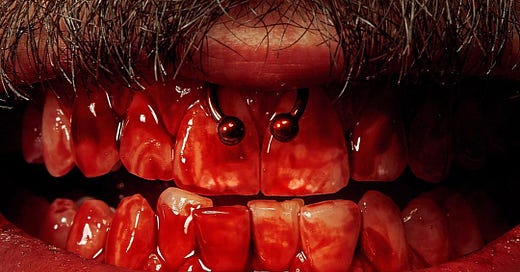Tastemakers used to be arseholes.
Now I’d kill for one.
(A tastemaker. Not an arsehole.)
You know what I mean though, right?
Vaunted magazine editors and influencers – true influencers – media empires, cultural gatekeepers, Graydon Carter, Anna Wintour, last of her kind…
Most of them are gone now.
They were part of broken models, replaced – by user-generated content, Youtubers, fragmented hype cycles, nano-influencers, barely legible ad-funded models. Shitty PR.
In this maelstrom, the feeds were outsourced to algorithms. Machines increasingly handle online curation for us, they do the heavy lifting of where to go and what to see. Compute rules us. We’re now seeing the first generation of adults whose online preferences have been guided almost entirely by algorithms.
This is problematic in the art world, because the spirit is about breaking new ground, and yet in their spare time, artists consume like all other audiences, and art is primarily discovered just like other content.
The capture of art, on smartphones and social media, is already shaping it; more broadly, algorithmic optimisation is making us all a little more boring, and even without it, look around – our scenes are full of Obvious Art.
Unguarded, it gets worse.
Venkatesh Rao foresaw a world where the only path forward for anyone hoping to transcend mediocrity, to create something interesting and be noticed for it, is to get above the algorithm.
If you’re below the algorithm, you’re subject to it. A machine directs you, the attention of your audience, your tastes, where you go, what you see, whether you realise it or not.
Above the algorithm, you are creating work that transcends the feed. Work that has not gone before, inspired by radical leaps, that’s experimental and risk-taking and dangerous, not a consolidation of prior tropes but a reimagination of reality. Material that simply slices through feeds and recommendation loops.
This conversation often feels muted when I talk to artists, partially because nobody minds when the people getting replaced and ignored are artists whose work they never liked anyway.
LOL.
But look at the music industry, look at publishing, look beyond; believe me: it’ll come for us all.
Then they came for the neo-industrial noise goths, and there was no one left to defend me – yes, our fate is to be in the long tail of Youtubers and Instagrammers, eaten up by a machine that spits out content and where we own nothing.
…
But it’s ok, sweetie
Daisy Alioto describes the emergent Taste Economy.
She calls out the powerful crossover of consumer and media brands, even the re-emergence of zines, where in the shifting landscape, some smart makers had the foresight to recognise that in an automated, algorithmically-optimised landscape, people crave the alchemy of really fucking good human taste.
And that taste – having it, using it, drawing people to your version of it – will be the defining competitive advantage in making work and getting attention for it. The disproportionate skill when many people have their behaviours set to automatic.
In art – less commercialised, more institutionalised, more stuck in its ways, more agitating for change, more hopeful, more helpless – we’ve got to ask hard questions. I spend a lot of time in galleries, looking at art. Most of it is banal.
How do resist the urge to compromise on how work is made, funded, shown and discovered, when time and money and inspiration is already so tight? Honourable mentions:
Dither is a media channel, but harnesses what I like to think of as more of a chaotic algorithm – human-led, full of raw opinion, dissent, a feral and free use of a feed.
A Single Piece is a gallery that creates new context for everything it shows in a way that is the opposite of machined optimisation. Each exhibition, each experience is uniquely built around just a single piece of work and a perfect space in which to experience it.
Exhibited.At explores new ways to champion, express and preserve digital art, and connect traditional buyers with new forms, and new audiences who always thought that art wasn’t for them.
Art Drunk is a gloriously informal backstage pass to artists and their work, stripped of pretension and constantly inventive in its choices.
Soft Centre for me represents a thrilling, challenging view of what future art can be, right at the edge of experimentation in media, performance and network.
Taste. Fuck.
I wish there was a better way to express it, because still it remains a stick to beat people with, a way to call somebody crass (“that bitch is so tasteless”), a truth that’s been co-opted by bullshitters:
But I believe it to be true.
A vital aspect in how we create, curate and canvas attention in a compute-driven world; post-AI, that success lies in great part to the cultivation and practice of a messier version of what a machine can do.
.
.
.
Go further:
Image: Luca Cacciapuoti






Great essay!
This is so accurate.